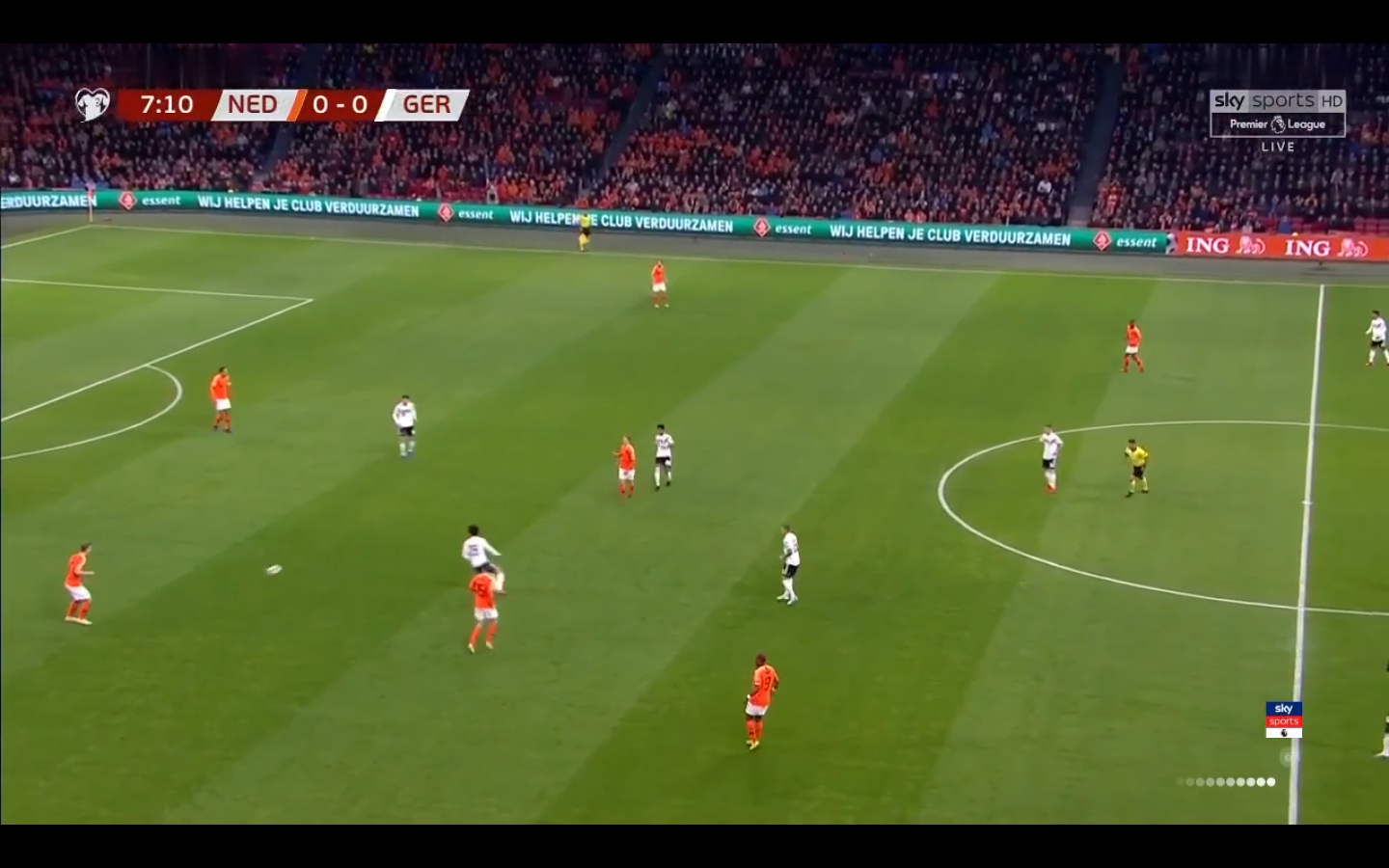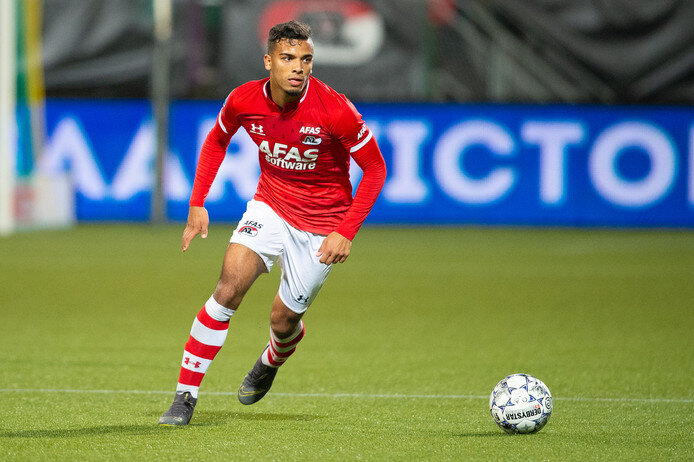How Germany scraped a 3-2 win against the Netherlands

Germany dominated the first half of their Euro 2020 qualifier against the Netherlands to banish the demons of the UEFA Nations League and race to a 2-0 lead. The Dutch then came back to level the score at 2-2 before a late Nico Schulz goal handed the Germans an important victory in qualifying. It was a game with many tactical tweaks from start to finish as both sides tried to adapt to each other. The match proved a spectacle as both teams are on a journey to replenish their core of talent before Euro 2020.
Dutch defend in a 5-4-1 with man-orientated pressure
In the lineups, one would not be forced to assume that the Dutch would play in their customary 4-3-3 but Ronald Koeman tasked Frenkie de Jong with dropping into a back five with the rest of the midfielders combining with the wingers to create a line of four behind Memphis Depay. The Dutch also pressed the ball in a man-orientated fashion as in the first wave of pressure, Ryan Babel and Depay would push up on the German three-chain in a 3v2 situation with Babel marking Matthias Ginter and Depay marking Niklas Sule. However, when the Germans would play the ball to one of their centre-backs or back-pass to the keeper, Quincy Promes would shift his attention from Nico Schulz and move forward to Antonio Rudiger with Denzel Dumfries pushing up from his right-back position to mark Schulz triggering an aggressive man-orientated press across the pitch.
Dumfries’ battle with Schulz would be an intriguing contest as Dumfries was tasked with pushing up to mark his wing-back but also covering for his centre-back when Leroy Sane and Serge Gnabry made movements to the wide areas and half-spaces. Dumfries is comfortable with winning the ball in the opposition half and making overlapping runs to stretch play as he does for PSV but was sometimes caught too narrow. Julian Nagelsmann has developed Nico Schulz into one of the better attacking wing-backs in Europe as he happily charged into the spaces that Dumfries left.
The above sequence was taken before the goal, the Dutch have lost the ball in build-up which is why Virgil Van Dijk is caught high and Matthijs De Ligt is caught wide. Dumfries cannot move outside to track Schulz as that would open a direct passing lane to Leroy Sane while he cannot push up to press Kroos in possession as that would leave De Ligt in a 2v1 predicament. Dumfries waits for Maarten De Roon to slide across and take the responsibility of Kroos while he backtracks to Schulz, Kroos beats De Roon and plays the ball to Schulz who is a few yards ahead of Dumfries to cross the ball for Sane to score.
The Germans suffocate Frenkie de Jong
“You can try to put Frenkie de Jong under pressure, but it does not help much, because he is such a player who dares to risk his game,” said Thomas Muller in quotes obtained from Voetbal International after Bayern Munich and Ajax played each other in the UEFA Champions League group stage.
The Germans went about limiting De Jong’s influence on the game by forcing him to drop into the Dutch three-chain to receive possession. The Germans would instantaneously put pressure on the future Barcelona midfielder even in these deep positions. If De Jong moved higher to receive the ball, he was caught in between the first wave of German pressure and the second wave of pressure with the primary wave tracking back to win possession from him while the secondary wave would push up. There was an instance where he received the ball in between the lines as Gnabry tracked back to win possession from him and forced an errant pass to Joshua Kimmich who drove into the box to be tackled by the Ajax man. The second wave of pressure also denied De Jong passing options in the central passing channels forcing him to play backwards and sideways passes.
Leon Goretzka and Serge Gnabry in between the lines
The Dutch National team were disorganised in interchanging during different phases of the game, especially in switching from a high press and dropping back into their 5-4-1 low block. This allowed the Germans to find spaces in between the lines, especially Goretzka, Gnabry and Sane. De Jong was tasked with dropping back into the back five as the midfield block of four would move deeper to close down the central pockets, but the Dutch did not transition into this phase quick enough. As de Jong would drop next to the centre-backs, there would be gaps for Gnabry and Goretzka to pull away from the five chain to receive possession.
There is a sequence of play in the video above where Goretzka plays a pass to Gnabry in the deeper areas for the Bayern Munich attacker to pass to Ginter who passed to Sule to play in Rudiger as the Chelsea centre-back pushed up while Gnabry dropped into the space vacated by De Jong. Rudiger then decided to chip a ball in behind to Goretzka who mis-timed his run and was found offside. The Netherlands were transitioning into their 5-4-1 low block but were so disjointed in their approach that it left ample space for Goretzka and Gnabry to move into in between the lines. During the sequence of play, Van Dijk tried to push up to put pressure on Gnabry which initially triggered Goretzka signalling to Rudiger that he could make a run in behind.
Netherlands switch to a 5-3-2 and move their block higher after half-time
To remedy their issues from the first half, Ronald Koeman responded by moving their defensive block higher which also allowed De Jong to move out of the three chain and only drop back into defence situationally. Quincy Promes who has been deployed as a wing-back during Pablo Machin’s tenure at Sevilla now had to fill the role at international level. Daley Blind could act as an extra centre-back while he would push back into his wing-back role to stretch play in attacking situations. With de Jong and Van Dijk playing closer to the half-way line, they could use their high-level anticipatory skills to push and win possession in counter-pressing situations. The Dutch managed to press and counter-press the ball much more efficiently with a higher line and a more secure midfield and attacking block.
Introduction of Bergwijn gives Depay more freedom
Ryan Babel was taken off for Bergwijn at half-time as the PSV winger ensured that Depay was allowed to pick up the ball in the deeper areas and move out wide. Bergwijn would move into the central striking position as in Mark Van Bommel’s PSV Eindhoven side, he is used to receiving possession in congested central areas. When Depay would move into the central striking space, Bergwijn would move wider but close in proximity to his former PSV teammate or he would dovetail (picture below) the Lyon attacker by moving into the ten space. The Dutch had better interchanges in the pockets to move the ball into the box while Depay was allowed to exert a much larger influence on the game.
Dumfries and Blind also added width to the game as De Roon/Wijnaldum and Promes would move into the left vertical zone to combine with the Ajax centre-back as he does not have the pace and athleticism to cover the left wing on his own. Bergwijn was allowed to come inside as Dumfries is so effective at making overlapping runs which helped Bergwijn as he is used to starting on the left flank and switching to the right intermittently at club level. The PSV right-back joined in on attacks to great extent and made some well-timed challenges on Schulz but had the misfortune of all three goals come from his flank. It was a little insight to why Koeman prefers the defensively sound Kenny Tete at right back as Dumfries will continue to grow with experience.
Conclusion
The Dutch have improved vastly in the last year under Koeman, but this game shows that he should tinker with his side in between International games as the Dutch have ample useful players at their disposal. The former Everton and Southampton manager made key in-game adjustments which helped his side gain a foothold in the match which is very inspiring for a young and evolving side going forward. During this international break, Loew has shown a willingness to break away from the club-level norms with Kimmich playing as a midfielder in both games and Gnabry playing upfront where he played last season at Hoffenheim. He altered his side from the last game as Koeman said pre-match that he did not know which system that Germany would play with. Both teams are evolving through this Euro 2020 qualifying campaign while they usher in a new generation of players.











